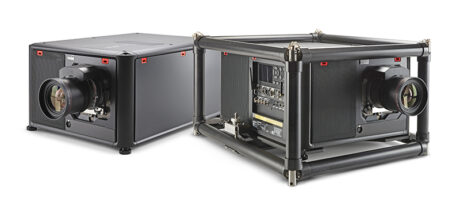 Barco, Inc.
Barco, Inc.
- Model Name: UDM-4K30
- Light Source: Laser phosphor with inorganic phosphor wheel
- Resolution: 3,840 x 2,400 (4K UHD) / 2,560 x 1,600 (Native) / 5,120 x 3,200 (Processing)
- Brightness: 25,000 ANSI / 25,500 Center / 27,000 ISO Lumens
- Contrast Ratio: Full field 2,200:1 / Barco Dyna Black 20,000:1
- Motorized Zoom: Yes, Zoom and Focus (with Lens Memory on TLD Lenses)
- Zoom Range: Motorized Lens Shift (with Position Memory on all Lenses)
- Lens Shift Range: Vertical Between -100% to +130%; Horizontal up to +/-40%, Depending on Lens
- Rigging Frame: Yes
- Voltage: 120-160V (Max 70% Brightness)
- Total Wattage: 1,300W Typical / 1,530W Max
- Dimensions (In.): 28.54 x 21.26 x 13.3
- Weight (lbs.): 105 lbs.
- Accessories: Power Cord, Wireless/XLR Wired Rugged Remote Control
- More Details: The compact and light-weight design of the UDM-4K30 saves installation time and reduces shipping and labor costs. The UDM projector offers a wide color spectrum outperforming the Rec. 709 color space.
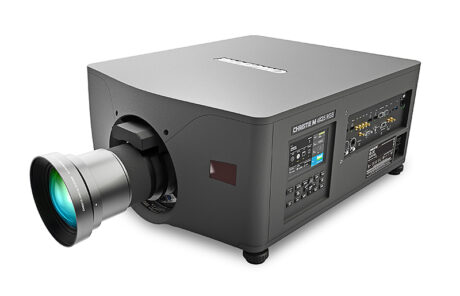
Christie
- Model Name: M 4K25 RGB
- Light Source: RGB Pure Laser
- Resolution: 3,840 x 2,160
- Brightness: 22, 500 ANSI/25,300 ISO Lumens
- Contrast Ratio: 3:000:1 On/Off
- Motorized Zoom: Yes
- Zoom Range: 0.37:01 Fixed; 6.9-10.4: 1 Zoom
- Lens Shift Range: Depends on Selected Lens
- Rigging Frame: Yes, Optional
- Voltage: Dual 200-240 VAC 9A 50/60 Hz Single phase, limited brightness mode; 100-120 VAC 12A 50/60 Hz
- Total Wattage: 1,540W Typical/1.800W Max
- Dimensions (In.): 10.6 x 24.3 x 20.7
- Weight (lbs.): 92 lbs.
- Accessories: Stacking Frame, Ceiling Mount, 12 Lenses Ranging from 0.38:01 Fixed – 6.9-10.4: 1 Zoom
- More Details: This 3DLP® RGB pure laser projector features Christie’s ‘all-in’ video processing plus electronic color convergence, and an intelligent lens system that’s compatible with Christie’s legacy M, J, and Crimson Series lenses.
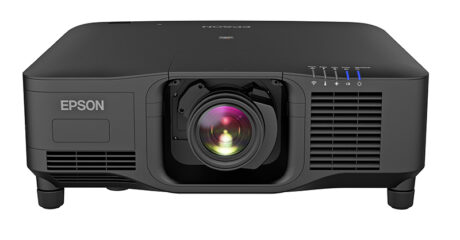
Epson America, Inc.
- Model Name: EB-PU2220B 3LCD Large Venue Laser Projector
- Light Source: Solid-State Laser Light Engine
- Resolution: Native WUXGA with 4K Enhancement Technology; 4.6 Million Pixels
- Brightness: 20,000 Lumens (Equal Color/White Brightness)
- Contrast Ratio: 2,500,000:1 Dynamic
- Motorized Zoom: Yes
- Zoom Range: Optical Zoom: 1.0 – 1.6
- Lens Shift Range: Vertical: ±60 percent; Horizontal: ±18 percent
- Rigging Frame: Yes
- Voltage: 220 – 240V
- Total Wattage: 1,301W
- Dimensions (In.): 8.6 x 23.1 x 19.4
- Weight (lbs.): 53.7 lbs.
- Accessories: Nine optional powered lenses including ultra short throw with .35 throw; attachable PixAlign™ camera; Ceiling Mount and Suspension Adapter; Wireless LAN module; Epson Projector Professional Tool (EPPT); Epson Projector Configuration Tool (EPCT) for NFC
- More Details: Optimized for live events. The EB-PU2220B 20,000-Lumen large-venue laser projector delivers ultra-bright, colorful images.

Panasonic Connect
- Model Name: PT-RQ25KU Series 3-Chip DLP™ Laser Projector
- Light Source: Laser Diode
- Resolution: 4K (3,840 x 2,400 Pixels with Quad Pixel Drive)
- Brightness: 20,000 / 21,000 (Center) Lumens
- Contrast Ratio: 20,000:1 (Full On/Full Off, Dynamic Contrast)
- Motorized Zoom: Yes
- Zoom Range: Vertical between +/- 5° to +/- 45°; Horizontal between +/- 0° to +/- 40°, Depending on Lens
- Lens Shift Range: Vertical: ±66 %; Horizontal: ±24 %
- Rigging Frame: Yes
- Voltage: 200 – 240V
- Total Wattage: 1,200W
- Dimensions (In.): 21-21/32 x 8-21/32 x 22-7/16
- Weight (lbs.): 77.2 lbs.
- Accessories: Logo Transfer Software, Multi Monitoring & Control Software, Early Warning Software, Geometry Manager Pro, Smart Projector Control for iOS/Android™
- More Details: The PT-RQ25KU Series is 40% smaller & 35% lighter than its predecessor, delivering up to 20,000 Lumens at 4K resolution. It’s Panasonic Connect’s first projector to be Intel® Smart Display Module-ready.
https://na.panasonic.com/us/audio-video-solutions/projectors/
IMAGING TECHNOLOGIES
All projectors have the same goal: visualization, showcasing an image on a canvas. But not all projectors are the same. Different projectors use different technologies.
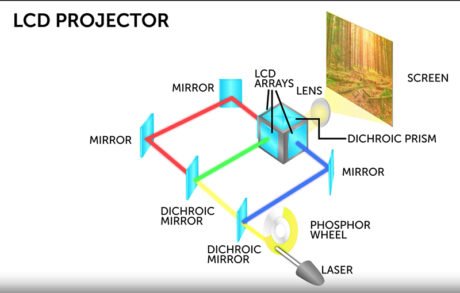
How LCD Projectors Work
LCD (Liquid Crystal Display) is a transmissive imaging technology. It means that the three colored beams (red, green and blue) formed by the light source pass through three LCD imagers, one for each primary color. These LCD cells are made out of a number of pixels and contain a liquid crystal layer, which is controlled via local electrical signals.
The signals affect the pixel in the layer and changes the polarization of the light. This change of polarization allows more or less light to pass through the polarizers placed at either side of the LCD module and this then forms a frame of the digital image.
Almost all LCD projectors have a three-chip architecture, which means that after the frames are formed by the polarizers, the three frames, one per color, are then combined into one through a color combination prism, and then projected through the projection lens onto the screen.
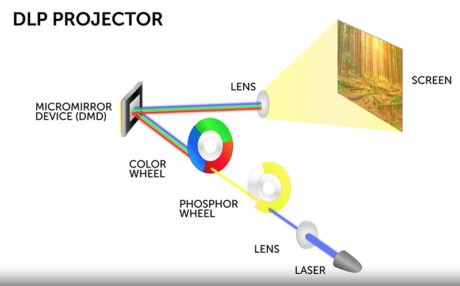
How DLP Projectors Work
A DLP (Digital Light Processing) projector, on the other hand, directs the red, green and blue light to one or more Digital Micromirror Devices (DMDs). As its name suggests, a DMD is covered with millions of microscopic mirrors and each of those tiny mirrors corresponds to the individual pixels of the image.
While projecting the image, the micro-mirrors alternate between their on and off positions. This means they change their orientation to either reflect the light towards the projector’s lens and onto the projection screen or the light is reflected away from the main lens into a light-absorbing area. It’s why DLP is called a reflective imaging technology. The mirrors’ ultrafast continuous on/off alternation defines the brightness and color of the corresponding pixels and forms the projected image.
In a single-chip DLP projector, each primary color is directed to the imager sequentially, and the image for each color is formed separately. Because it happens so fast our brain is able to blend the images into a full-color result. 3DLP, like the 3LCD projectors, use three imagers which will form the red, green and blue image simultaneously.
This excerpt of information was shared from Barco’s Inspiration page on their website. Read the entire piece at: https://www.barco.com/na-en/inspiration/news-insights/2022-01-19-dlp-vs-lcd-projectors


